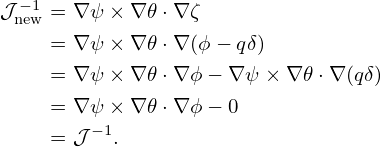
In solving the MHD eigenmode equations in toroidal geometries, besides the B ⋅∇ operator, we will also encounter another surface operator (B×∇ψ∕B2) ⋅∇. Next, we derive the form of the this operator in (ψ,𝜃,ζ) coordinate system. Using the covariant form of the equilibrium magnetic field [Eq. (284)], we obtain
 | (287) |
Using this, the (B ×∇ψ∕B2) ⋅∇ operator is written as
which is the form of the operator in (ψ,𝜃,ζ) coordinate system.Examining Eq. (289), we find that the coefficients before the two partial derivatives will be independent of 𝜃 and ζ if the Jacobian 𝒥 is chosen to be of the form 𝒥 = h(ψ)∕B2, where h is some magnetic surface function. It is obvious that the independence of the coefficients on 𝜃 and ζ will be advantageous to some applications. The coordinate system (ψ,𝜃,ζ) with the particular choice of 𝒥 = h(ψ)∕B2 is called the Boozer coordinates. The usefulness of the new toroidal angle ζ is highlighted in Boozer’s choice of the Jacobian, which makes both B ⋅∇ and (B ×∇ψ∕B2) ⋅∇ be a constant-coefficient differential operator. For other choices of the Jacobian, only the B⋅∇ operator is a constant-coefficient differential operator.